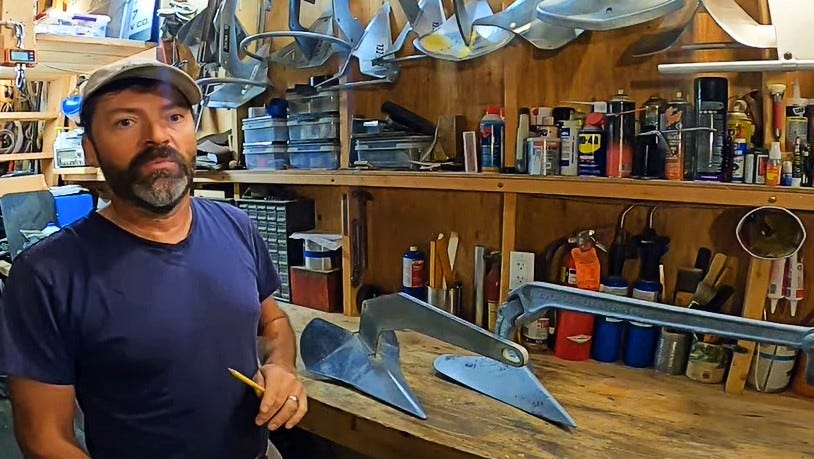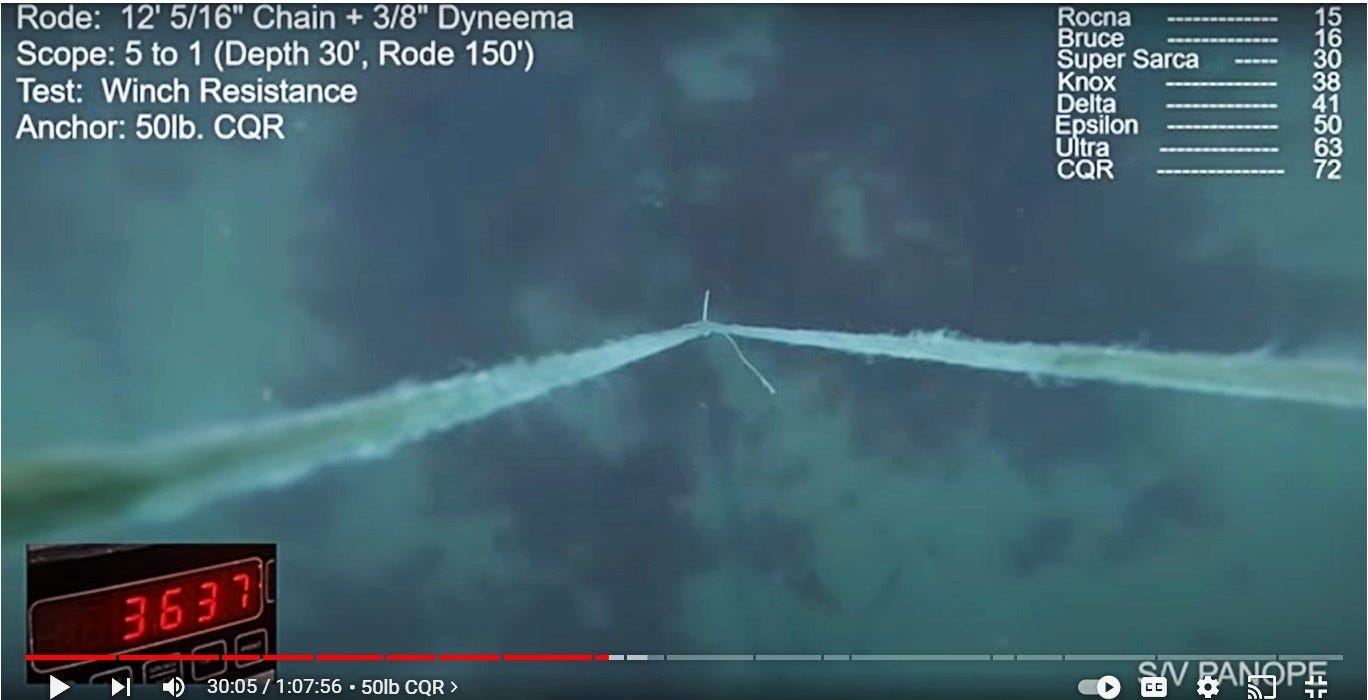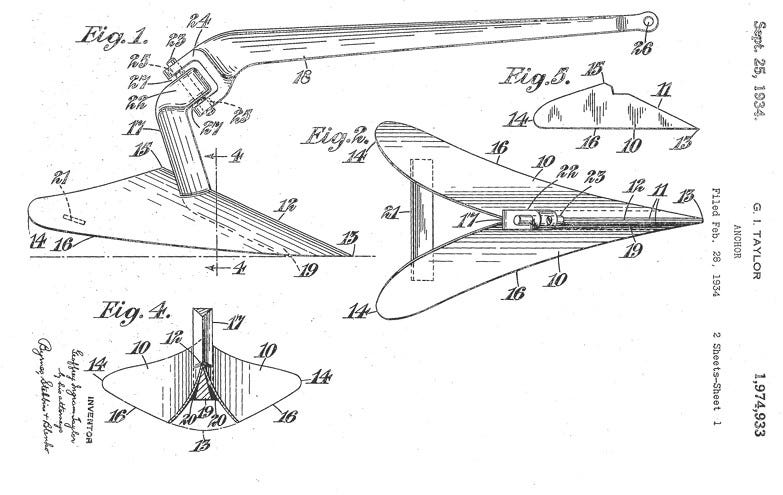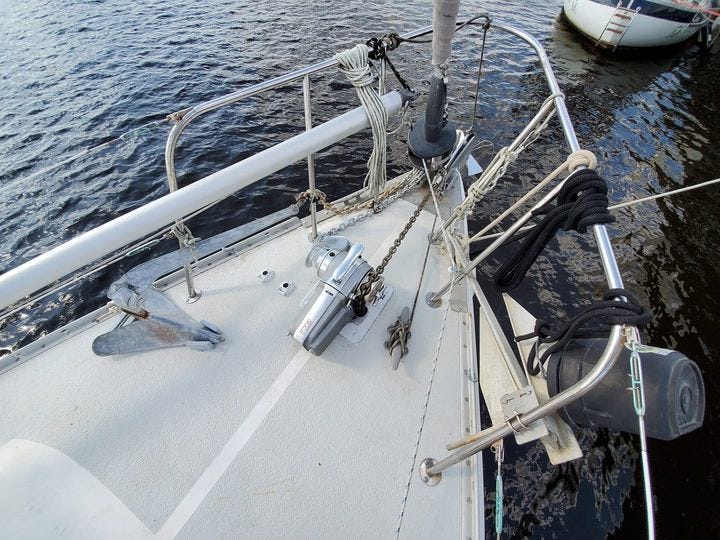The CQR Ain't That Bad After All, Tests Show
Pacific Northwest Sailor's YouTube Series Takes Anchor Testing to a New Level

This story was originally published in March 2023. It is reprinted here as part of a plan to introduce thousands of new subscribers to some of our best stories from the past.
There’s a guy over in Washington State who’s published more than 140 videos showing how individual anchors behave underwater and under load. No, the tests don’t prove that CQR is the GOAT, but unlike what you may have heard down on the docks, it doesn’t suck either.
That’s the news here. According to Steve Goodwin of S/V Panope, CQR came out ahead of several “modern” anchors, including the Epsilon, Knox, Bruce and (dare I say it) Rocna. Given the worshipful regard for that particular hunk of steel, the conclusion is nothing short of heresy.
Peter Smith is an accomplished sailor and designer of the Rocna anchor. He famously dismissed anyone who still valued their CQR as a narrow-minded Luddite.
“A schism exists between these more open-minded boaters and those who value the ‘tried and true’ and the traditional; and who, despite the bemusement of the early adopters of what is clearly far superior technology, continue to use designs that in the case of the CQR is (without hyperbole) rather akin to the use of cotton sails and oil lanterns,” Smith wrote.
Goodwin used a test boat and a metered winch to conduct all sorts of tests in sand, sandy mud, soft mud and “cobblestone” bottoms. The tests included straight pulls, 180-degree reverses and veering.
The best all-around performer in the 40– to 50-pound class was the Viking. Right behind it was the Vulcan, which is made by Rocna (in case you imagined that Goodwin might be some kind of a Rocna-hater). Also performing generally better than the CQR were equivalent Mantus, Spade and Ultra anchors.
In the soft mud categories, however, the CQR was shown to be as good as Viking and Vulcan. In a straight pull in sandy mud, the CQR registered as high as 3,600 pounds of resistance, nearly as good as the Viking and Vulcan. This is all on video, recorded by an underwater camera tethered to each anchor. No one is making this up.
Another video in the series evaluated anchors in the 20- to 30-pound category and included a direct comparison of equivalent CQR and Delta models.
“I’m pretty comfortable stating that with the Pacific Northwest and the seabeds we typically have, gotta go with the CQR,” Goodwin said.
Goodwin had recently conducted an anchor survey on the docks of Port Townsend, Washington, which showed CQR to be the most numerous type. “And I wouldn’t say the Port Townsend sailors are a bunch of marina queens. Pretty salty place and most people get out and about and anchor a lot. And they use a lot of CQR anchors to good effect,” he said.

In a disclaimer, Goodwin stresses that his test results may not reflect experience with seabeds elsewhere in the world. However, it is difficult to imagine why his results wouldn’t also apply to the U.S. East Coast and the West Indies.
The most popular boating state in the U.S., Florida’s waters are nearly all sandy mud or soft mud. The Bahamas are mostly sand. The Chesapeake Bay bottom is so muddy that you may hear the locals chuckling if you show up at gas dock on, say, Kent Island, Maryland, with a Delta hanging off the bow. And the Northeast is a mixed bag of muddy, sandy and rocky bottoms.
Sir Geoffrey Ingram Taylor developed CQR in 1933 as an anchor for flying boats in time for World War II, with the British Navy buying 60,000. You might say it was the first “modern” anchor, arriving nearly a decade before the Danforth. During the next six decades it reigned as America’s most popular sailboat anchor.

Goodwin explained why he thinks CQR lost in mojo in popular imagination.
For many decades this was the best anchor for cruising-style boats. They’ve developed a bad reputation among a lot of people, and I think part of that is warranted. I think the low tip weight and the general nature of this anchor—it’s known that these anchors will have trouble setting in difficult-to-penetrate seabeds.
I think another problem these anchors have had to face is that, over time and use, the hinge point rusts and wears. the angle between the shank and the tip—the throat angle—opens up. And I’m pretty sure that when that happens, the performance of the anchor suffers…
Another reason for the poor reputation likely comes from the fact that this anchor has been so heavily copied. There’s just been countless other manufacturers that have done their version of the CQR over the years. A lot of people will just look at a convex anchor with a hinge and call it a CQR.
In my former life as a boating magazine editor, I worked with retired West Marine exec Chuck Hawley to develop an online course called Anchors and Anchoring. Hawley, whose job had been to evaluate products for the national retailer, had also conducted extensive anchor pull tests for the Fortress anchor company, pitting all the major brands against one another. He once told me he had to resist exhortations to tip the scales in favor of the sponsor.
Our anchor videos felt like a major undertaking at the time, but they were a small thing compared to Goodwin’s continuing enterprise over in Washington. Yet, the man’s seven-year effort is being summarily dismissed by folks who, I would imagine, paid a lot of money and therefore their anchor is best dammit.
One sailor opined on Facebook that Goodwin’s tests were intentionally bogus to drive views on YouTube for profit. How would doing tests badly boost the channel’s popularity, I asked? The tests had to be bogus because CQRs suck, he said. After I asked whether he had any personal experience with a CQR, the post disappeared.
The big loser in Goodwin’s testing was the Delta, which is a very popular anchor. I have a shiny stainless Delta-style anchor hanging off my own bow. I used to have a CQR there, but I lost it during Hurricane Irma (while it was temporarily assigned to another vessel).
A few years ago, I added a sweet new windlass and fashioned chocks for a back-up CQR to port (yup, I had owned two) and hung a Danforth on the pulpit to starboard, either of which could be quickly attached to a secondary rode. I posted a picture on my Facebook page.
A Very Exalted Figure in the cruising community actually gave me shit, which in hindsight was ironic, because he was berating me for the CQR, not the now undeniably poorly performing Delta. “It’s just a sign that says, ‘I haven’t used a modern anchor, and I’m stuck in the past’,” he wrote, referring to the CQR.
Please excuse me now. The sun is setting, and I need to fill my lanterns. I’ll need light. I’m expecting some nasty telegrams from the Rocna Fan Club.






Anchors are an ongoing cruising and boating topic, and everyone has an opinion. Who knew that confirmation bias was not just a political thIng?
I’m a CQR fan, but now I have a Rocna. I’m actually agreeing with you, though. CQR works great on everything I’ve tried in US waters from Great Lakes, Charleston, Florida Coast and North Gulf of Mexico, and even works well in the uncharted Gulf of America.
But in the hard coral sand around the Exumas, only danforth (style) and Rockna made me happy. Even with 60’ of 1/4 G4, CQR wouldn’t set without me diving and digging a hole. But the CQR is still my old friend. I’m gonna mount it on the front of my 32yo jeep next to the Winch. That should scream redneck sailor.